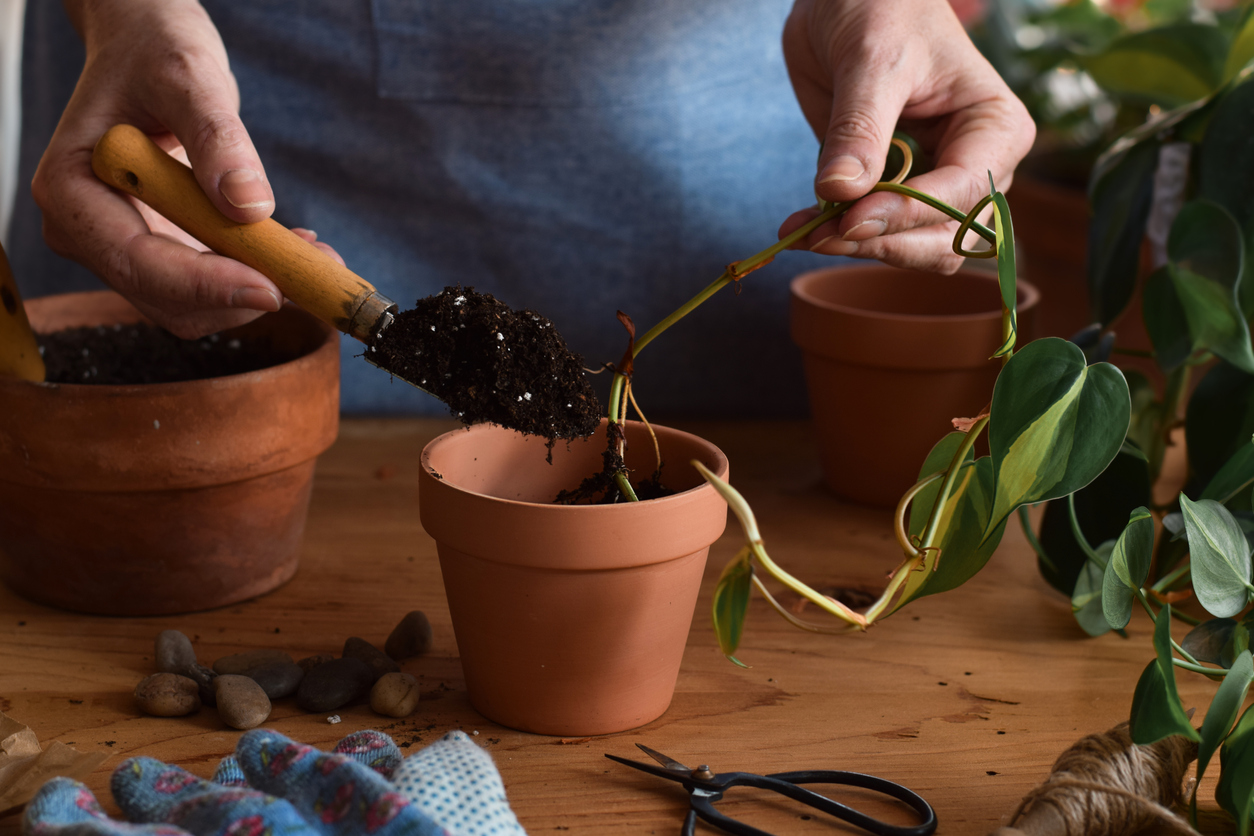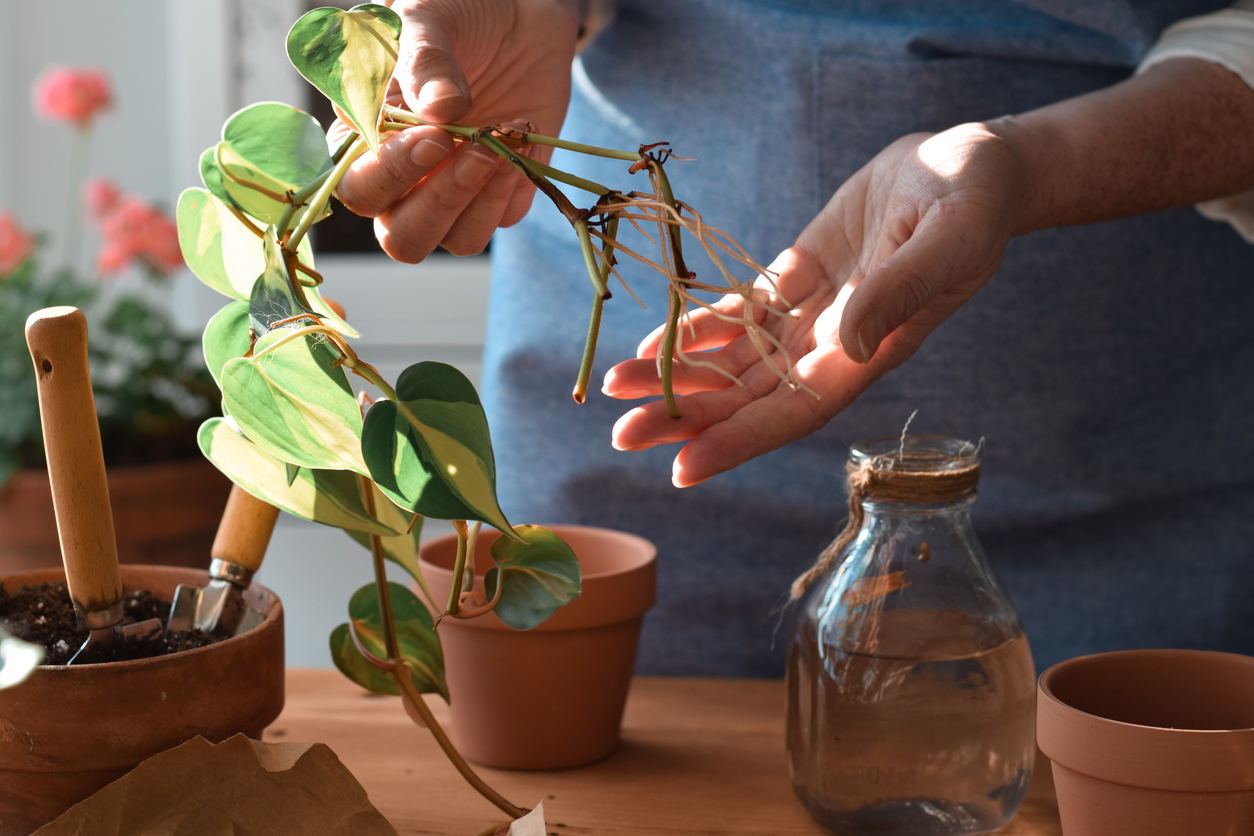

We may earn revenue from the products available on this page and participate in affiliate programs. Learn More ›
Among the easiest houseplants to grow, pothos (Epipremnum aurum) is a vigorous viner that throws out heart-shaped, green, yellow, or variegated leaves in rapid succession. Common pothos varieties include ‘Jade,’ ‘Neon,’ and ‘Marble Queen,’ and the below pothos propagation methods are sure to work on virtually any pothos species or variety.
Being such a peppy plant (which is also called devil’s ivy due to its aggressive attitude), pothos is one of the easiest plant genii to reproduce. So, if you include pruning in your pothos plant care, you may want to save a few cuttings and read on to find out how to propagate pothos with tools that you probably already have around the house.
RELATED: 10 Houseplants You Can Propagate the Fastest for an Ever-Expanding Indoor Garden
How to Propagate Pothos in Soil

When contemplating how to propagate pothos in soil, keep in mind that it usually is best to use a sterile medium—such as perlite, vermiculite, or seed starting mix—as your “soil” for plant propagation. However, easy-to-start plant such as this one usually will root in potting soil, too.
SUPPLIES
– Flower pot
– Perlite, vermiculite, seed starting mix, or potting mix
– Pruning shears
– Pencil
– Large plastic bag
STEP 1: Fill a flowerpot with whatever rooting medium you have chosen.
A shallow, 6-inch pot will work well. As was previously mentioned, although sterile mediums usually are employed for the rooting of cuttings, standard potting soil should suffice for this particular plant and would eliminate the necessity for transplanting later. Just make sure that whatever medium you choose remains lightly damp but not soggy throughout the rooting process.
STEP 2: Snip several cuttings from the tips of your pothos plant.
Wondering where to cut pothos to propagate it? Use pruning shears to sever a few 3- to 6-inch cuttings from the tips of a pothos plant’s vines. Make sure that each cutting has at least two nodes on it (the points where the leaves join the stem). Remove the leaves from the lowest node or nodes, allowing one or two leaves to remain on the top of the cutting.
STEP 3: Place them in the rooting medium with their bases covered.
Use a pencil to make holes in the rooting medium, 2 inches apart and deep enough to insert the bases of the cuttings so that their bare nodes are covered, tamping the medium around the bases. Then place a large, inverted transparent plastic bag over the pot making sure that it doesn’t touch the cuttings. Set the pot in a warm location with bright, indirect light or under a grow light until the cuttings begin to make new growth in 3 to 6 weeks. If tugging on them proves they have rooted, transplant them into pothos soil—standard potting mix.
RELATED: Air Layering Makes Propagating Your Favorite Plants a Cinch—Here’s How
How to Propagate Pothos in Water

Those who prefer an easier method might want to consider learning how to propagate pothos in water instead. The instructions for taking the cuttings are the same. It is just the rooting medium that is different.
SUPPLIES
– Glass, jar, or propagation station
– Pruning shears
– Flower pot
– Potting soil
STEP 1: Pour a little water into the bottom of a glass.
Although a juice glass or jelly jar often is recommended so you can see the roots when they form, almost any transparent container will work for that purpose as long as it holds a small amount of water. That amounts to about an inch of water or whatever depth is needed to cover the bare nodes. You also can purchase propagation stations that include stands for their glass containers.
STEP 2: Snip several cuttings from the tips of a pothos plant.
Use pruning shears to cut several 3- to 6-inch cuttings from the tips of a pothos plant’s vines. Make sure that each cutting has at least two nodes on it (the points where the leaves join the stem). Remove the leaves from the lowest node or nodes, allowing one or two leaves to remain on the top of the cutting.
STEP 3: Place the cuttings in the water, their lower nodes covered.
Set the glass in a warm, bright location out of direct sun, adding more water as necessary and changing the water weekly, until you see roots form on the cuttings. Barbara Pleasant, author of The Complete Houseplant Survival Manual, offers the following advice: “When roots and new leaves start to form, I add a spoonful of potting soil to the water, and then another the next day. The roots that grew in water respond by growing fine root hairs around the soil particles, which makes transplanting less traumatic for the plant.”
RELATED: Propagate New Plants With Our Faovirte Rooting Hormone
How to Propagate Pothos by Layering

Yet another method for propagating pothos plants is layering. It allows a stem to take root while still attached to the mother plant. As North Carolina State Extension notes, “This method of vegetative propagation is generally successful, because water stress is minimized, and carbohydrate and mineral nutrient levels are high.”
MATERIALS AND TOOLS
– Flower pot
– Potting soil
– Landscape staples
– Pruning shears
STEP 1: Fill a flowerpot with potting soil or a sterile medium.
As was mentioned above, for golden pothos propagation—or any other pothos for that matter—you probably can get away with potting soil instead of a more sterile medium. However, that won’t always work for less easy-to-root plants. Position the pot close beside the one that contains the mother plant.
STEP 2: Lay a vine from the plant across the pot’s surface.
Choose a vine from the mother plant and lay it across the surface of the filled pot. Allow a leaf to remain at the tip and remove the one beneath it. Allow the next leaf to remain and strip off the one below it, etc. With the tip leaf protruding from the soil, bury the next (bare) node beneath the soil or other medium. Continue allowing the remaining leaves to protrude above the soil and burying the bare nodes between them beneath that soil, pinning them down with landscape staples. When you are finished, the vine should make a serpentine pattern.
STEP 3: After a few weeks, check the pothos vine for roots.
After a few weeks, remove the staples and give the vine a light tug to see whether roots have developed at the nodes. If it appears to be rooted, you can dig it up and snip it into several cuttings. Each one should have roots, a length of stem, and a leaf. You can repot all of them in the same pot for a lush look or divide them among other pots.
RELATED: 20 Outdoor Plants You Can Propagate From Cuttings
Final Thoughts
If you follow one of these methods you shouldn’t have much trouble turning your devil’s ivy into a plethora of ivy imps! When considering pothos propagation in water, just keep in mind the advice of David Graper of North Dakota State Extension. He says that roots formed in a rooting medium will likely be stronger and healthier, and more likely to adapt well to growing in regular potting soil than roots that form in water. However, Pleasant’s hint of gradually adding soil should help “water roots” adjust to the change. Wait until they are at least an inch long to pot up the cuttings.
